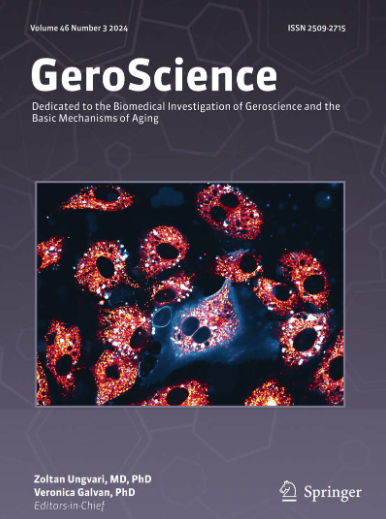Effects of aerobic exercise and cardiorespiratory fitness on white matter free water fraction in older adults: a 1-year randomized controlled trial.
IF 5.3
2区 医学
Q1 GERIATRICS & GERONTOLOGY
引用次数: 0
Abstract
Free water fraction (FWF), derived from diffusion MRI, is a sensitive biomarker of white matter microstructure and may be modifiable through lifestyle interventions. The mid-anterior corpus callosum (CC) has been proposed as particularly responsive to physical exercise and the related increases in cardiorespiratory fitness. This study examined the effects of aerobic exercise training and fitness on FWF in the CC and on cognitive performance in older adults. Seventy-three participants (mean age 69 ± 5 years, 77% women) were randomized to a 1-year aerobic training or stretching intervention. FWF was assessed using diffusion tensor MRI, fitness via maximal oxygen uptake (VO2max), and cognition using a composite score of reasoning, memory, and processing speed. Linear mixed models revealed a significant increase in VO2max following aerobic training compared to stretching, while cognitive performance improved in both groups. A significant region × group × time interaction was observed for FWF, although Bonferroni-corrected pairwise comparisons showed no significant group difference. However, complete-case analysis of the mid-anterior CC showed a significant FWF reduction in the CC body following aerobic training compared to stretching (- 2.71 ± 5.44% vs. 0.63 ± 6.42%, p = 0.048). Tract-based spatial statistics indicated that lower baseline VO2max predicted greater FWF increases in the CC body and genu across groups. Baseline FWF was negatively correlated with cognitive performance. These findings suggest that 1 year of aerobic training may reduce FWF in the CC body and that higher physical fitness preserves white matter microstructure and support cognitive health in older adults.有氧运动和心肺健康对老年人白质游离水分数的影响:一项为期一年的随机对照试验。
来自扩散MRI的游离水分数(FWF)是白质微观结构的敏感生物标志物,可以通过生活方式干预来改变。中前胼胝体(CC)被认为对体育锻炼和相关的心肺健康的增加特别敏感。本研究考察了有氧运动训练和健身对老年人CC中FWF和认知表现的影响。73名参与者(平均年龄69±5岁,77%为女性)被随机分为1年有氧训练或拉伸干预组。通过扩散张量MRI评估FWF,通过最大摄氧量(VO2max)评估适应度,通过推理、记忆和处理速度的综合评分评估认知能力。线性混合模型显示,与拉伸相比,有氧训练后的最大摄氧量显著增加,而两组的认知能力都有所改善。尽管bonferroni校正的两两比较没有发现显著的组间差异,但FWF存在显著的区域×组×时间相互作用。然而,中前部CC的全病例分析显示,与拉伸相比,有氧训练显著降低了CC体的FWF(- 2.71±5.44% vs. 0.63±6.42%,p = 0.048)。基于通道的空间统计表明,基线VO2max越低,各组CC体和膝FWF增加越大。基线FWF与认知表现呈负相关。这些发现表明,1年的有氧训练可以减少CC体的FWF,较高的身体素质可以保持白质微观结构,并支持老年人的认知健康。
本文章由计算机程序翻译,如有差异,请以英文原文为准。
求助全文
约1分钟内获得全文
求助全文
来源期刊

GeroScience
Medicine-Complementary and Alternative Medicine
CiteScore
10.50
自引率
5.40%
发文量
182
期刊介绍:
GeroScience is a bi-monthly, international, peer-reviewed journal that publishes articles related to research in the biology of aging and research on biomedical applications that impact aging. The scope of articles to be considered include evolutionary biology, biophysics, genetics, genomics, proteomics, molecular biology, cell biology, biochemistry, endocrinology, immunology, physiology, pharmacology, neuroscience, and psychology.
 求助内容:
求助内容: 应助结果提醒方式:
应助结果提醒方式:


